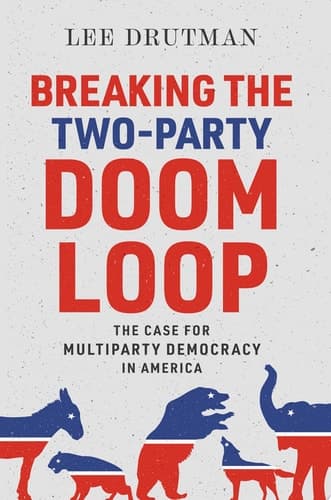
Breaking the Two-Party Doom Loop: The Case for Multiparty Democracy in America
by Lee Drutman
Published 2020 by Oxford University Press
368 pages
About this book:
American democracy is at an impasse. After years of zero-sum partisan trench warfare, our political institutions are deteriorating. Our norms are collapsing. Democrats and Republicans no longer merely argue; they cut off contact with each other. In short, the two-party system is breaking our democracy, and driving us all crazy.
Deftly weaving together history, democratic theory, and cutting edge political science research, Drutman tells the story of how American politics became so toxic, why the country is trapped in a doom loop of escalating two-party warfare, and why it is destroying the shared sense of fairness and legitimacy on which democracy depends. He argues that the only way out is to have more partisanship-more parties, to short-circuit the zero-sum nature of binary partisan conflict. American democracy was once stable because the two parties held within them multiple factions, which made it possible to assemble flexible majorities and kept the temperature of political combat from overheating. But as conservative Southern Democrats and liberal Northeastern Republicans disappeared, partisan conflict flattened and pulled apart. Once the parties fully separated, toxic partisanship took over. With the two parties divided over competing visions of national identity, Democrats and Republicans no longer see each other as opponents, but as enemies. And the more the conflict escalates, the shakier our democracy feels.
Breaking the Two-Party Doom Loop makes a compelling case for large scale electoral reform-importantly, reform not requiring a constitutional amendment-that would give America more parties, making American democracy more representative, more responsive, and ultimately more stable.
Deftly weaving together history, democratic theory, and cutting edge political science research, Drutman tells the story of how American politics became so toxic, why the country is trapped in a doom loop of escalating two-party warfare, and why it is destroying the shared sense of fairness and legitimacy on which democracy depends. He argues that the only way out is to have more partisanship-more parties, to short-circuit the zero-sum nature of binary partisan conflict. American democracy was once stable because the two parties held within them multiple factions, which made it possible to assemble flexible majorities and kept the temperature of political combat from overheating. But as conservative Southern Democrats and liberal Northeastern Republicans disappeared, partisan conflict flattened and pulled apart. Once the parties fully separated, toxic partisanship took over. With the two parties divided over competing visions of national identity, Democrats and Republicans no longer see each other as opponents, but as enemies. And the more the conflict escalates, the shakier our democracy feels.
Breaking the Two-Party Doom Loop makes a compelling case for large scale electoral reform-importantly, reform not requiring a constitutional amendment-that would give America more parties, making American democracy more representative, more responsive, and ultimately more stable.
Recommended in:
- Ask Ezra Anything: Degrowth, Third Parties, Reading and More (Aug 31, 2021) with Annie Galvin
Recommended with:

Rich Man Poor Bank: What the banks DON'T want you to know about money
Mark J Quann

Buddhism Without Beliefs
Stephen Batchelor

Seeing That Frees: Meditations on Emptiness and Dependent Arising
Rob Burbea

The Sandman: Overture
Neil Gaiman

Supergods
Grant Morrison

Here We Are: Notes for Living on Planet Earth
Oliver Jeffers